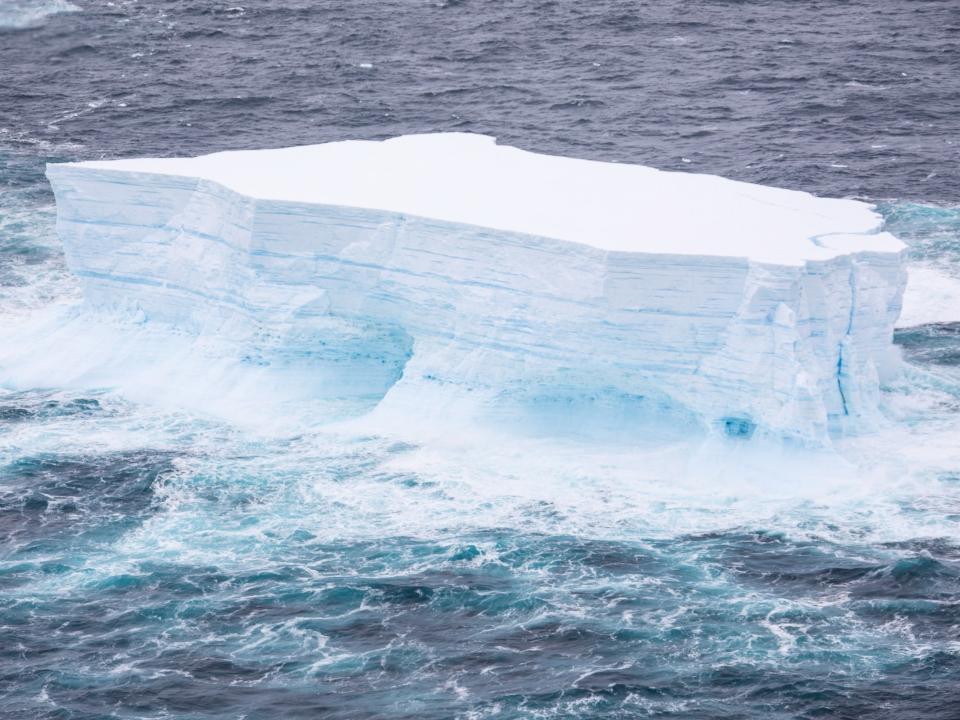Climate crisis: Global ice loss is speeding up, study finds

One of the largest icebergs ever recorded was photographed as it floated from Antarctica towards the island of South Georgia
(EPA)Ice is disappearing across the planet at an increasing rate, according to research which shows 28 trillion tonnes was lost between 1994 and 2017.
Scientists found that the rate of melting had accelerated from 0.8 trillion tons per year in the 1990s to 1.3 trillion tonnes by 2017.
The total lost over that period is the equivalent of a sheet of ice 100m thick covering the whole of the UK.
It has contributed as much as 3.5cm to global sea levels during that time, increasing the risk of flooding in coastal communities and threatening to wipe out precarious habitats.
The increase in ice loss has been triggered by global warming, with more than two-thirds of the total driven by rising atmospheric temperatures (0.26C per decade since the 1980s) and 32 per cent by rising ocean temperatures (0.12C per decade).
According to the study – the first survey of global ice loss using satellite data – there has been a 65 per cent increase in the rate of ice loss over the 23-year period, mainly driven by steep rises in losses from the polar ice sheets in Antarctica and Greenland.
“Although every region we studied lost ice, losses from the Antarctic and Greenland ice sheets have accelerated the most,” said lead author Dr Thomas Slater, a research fellow at Leeds’ Centre for Polar Observation and Modelling.
“The ice sheets are now following the worst-case climate warming scenarios set out by the Intergovernmental Panel on Climate Change. Sea-level rise on this scale will have very serious impacts on coastal communities this century.”
The survey covered 215,000 mountain glaciers spread around the planet, the polar ice sheets in Greenland and Antarctica, the ice shelves floating around Antarctica, and sea ice drifting in the Arctic and Southern Oceans.
The biggest losses were from Arctic sea ice (7.6 trillion tonnes) and Antarctic ice shelves (6.5 trillion tonnes), both of which float on the polar oceans.
Half of all losses were from ice on land – including 6.1 trillion tonnes from mountain glaciers, 3.8 trillion tonnes from the Greenland ice sheet, and 2.5 trillion tonnes from the Antarctic ice sheet. These losses have raised global sea levels by 35mm, and it is estimated that around 1 million people are in danger of being displaced for every centimetre of sea-level rise.
Dr Isobel Lawrence, a research fellow at Leeds’ Centre for Polar Observation and Modelling, said: “One of the key roles of Arctic sea ice is to reflect solar radiation back into space which helps keep the Arctic cool. As the sea ice shrinks, more solar energy is being absorbed by the oceans and atmosphere, causing the Arctic to warm faster than anywhere else on the planet.
“Not only is this speeding up sea ice melt, it’s also exacerbating the melting of glaciers and ice sheets which causes sea levels to rise.”
Glaciers have contributed to almost one-quarter of the global ice losses over the study period, despite storing only 1 per cent of the Earth’s total ice volume.
Report co-author and PhD researcher Ines Otosaka said: “As well as contributing to global mean sea-level rise, mountain glaciers are also critical as a freshwater resource for local communities.
“The retreat of glaciers around the world is therefore of crucial importance at both local and global scales.”
The research, led by the University of Leeds with assistance from the University of Edinburgh, University College London and data science specialists Earthwave, was funded by UK Natural Environment Research Council and is published in European Geosciences Union’s journal The Cryosphere. A preprint of the research was published last August.
Read More
Storm Christoph flooding a harbinger of worsening ‘climate shocks’

 Yahoo Finance
Yahoo Finance 